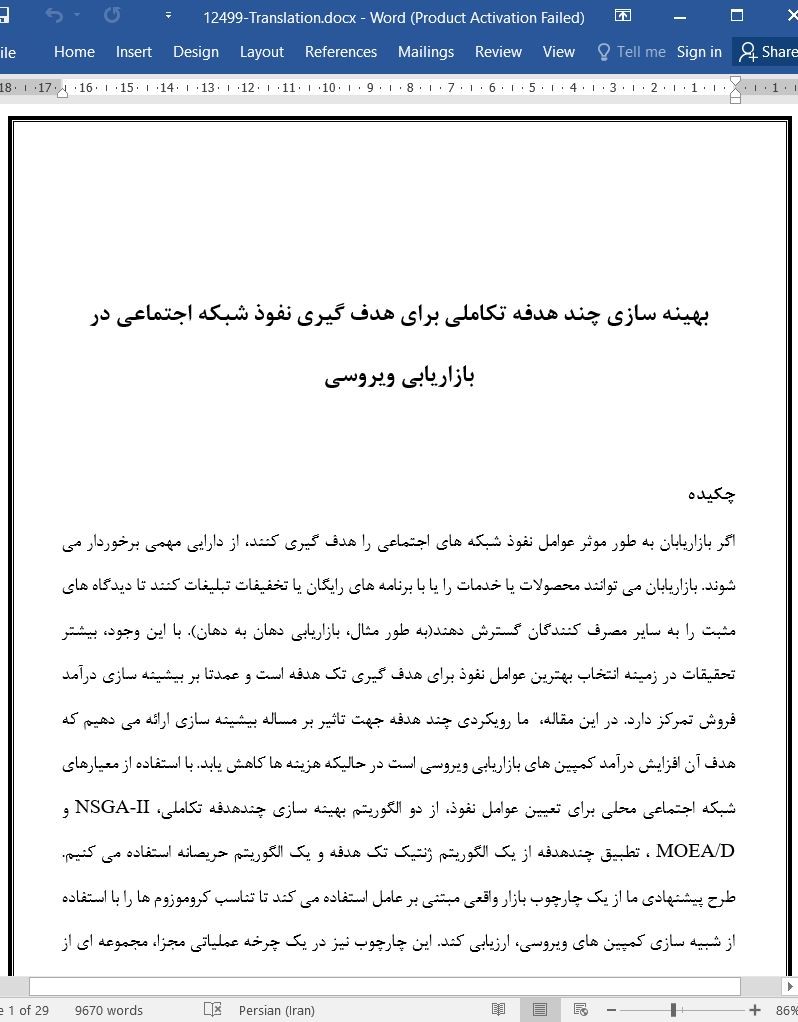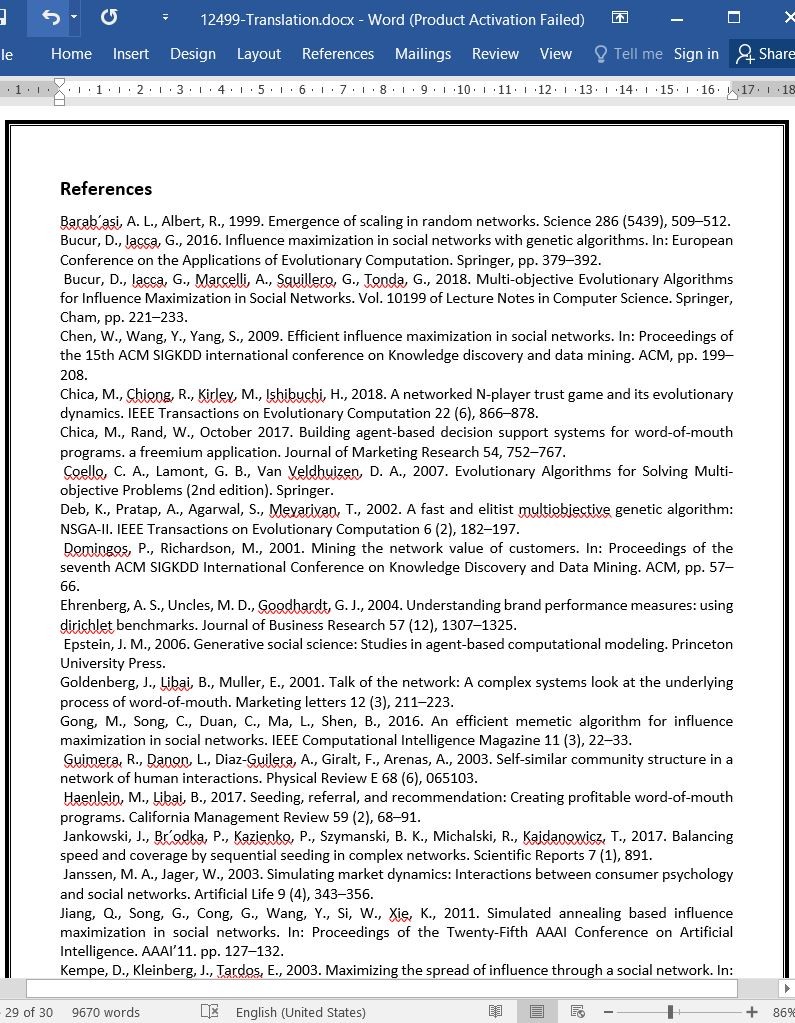
دانلود مقاله بهینه سازی چند هدفه تکاملی برای هدف گیری نفوذ شبکه اجتماعی در بازاریابی ویروسی
چکیده
اگر بازاریابان به طور موثر عوامل نفوذ شبکه های اجتماعی را هدف گیری کنند، از دارایی مهمی برخوردار می شوند. بازاریابان می توانند محصولات یا خدمات را یا با برنامه های رایگان یا تخفیفات تبلیغات کنند تا دیدگاه های مثبت را به سایر مصرف کنندگان گسترش دهند(به طور مثال، بازاریابی دهان به دهان). با این وجود، بیشتر تحقیقات در زمینه انتخاب بهترین عوامل نفوذ برای هدف گیری تک هدفه است و عمدتا بر بیشینه سازی درآمد فروش تمرکز دارد. در این مقاله، ما رویکردی چند هدفه جهت تاثیر بر مساله بیشینه سازی ارائه می دهیم که هدف آن افزایش درآمد کمپین های بازاریابی ویروسی است در حالیکه هزینه ها کاهش یابد. با استفاده از معیارهای شبکه اجتماعی محلی برای تعیین عوامل نفوذ، از دو الگوریتم بهینه سازی چندهدفه تکاملی، NSGA-II و MOEA/D ، تطبیق چندهدفه از یک الگوریتم ژنتیک تک هدفه و یک الگوریتم حریصانه استفاده می کنیم. طرح پیشنهادی ما از یک چارچوب بازار واقعی مبتنی بر عامل استفاده می کند تا تناسب کروموزوم ها را با استفاده از شبیه سازی کمپین های ویروسی، ارزیابی کند. این چارچوب نیز در یک چرخه عملیاتی مجزا، مجموعه ای از راه حل های غیرغالب ایجاد می کند که بازاریابان را قادر می سازد تا در یک چرخه عملیاتی مجزا، گزینه های هدف گیری چندگانه را در نظر بگیرند. این الگوریتم ها بر اساس پنج توپولوژی شبکه و شبکه اجتماعی ایجاد داده های واقعی، ارزیابی می شوند، که نشان می دهد MOEA/D و NSGA-II بهتر از رویکردهای تک هدفه و حریصانه هستند. جالب تر اینکه، نشان می دهیم که بین عملکرد الگوریتم ها و ویژگی های انتشار شبکه های اجتماعی، ارتباط آشکاری وجود دارد.
1. مقدمه
شبکه های اجتماعی آنلاین مانند فیس بوک یا اینستا گرام موجب می شوند، افراد(مصرف کنندگان بالقوه) بیش از هر زمان دیگری، با هم ارتباط داشته باشند. مصرف کنندگان تنها با اقدامات معدودی، می توانند فورا با دیدگاههای محصولات و برندها ارتباط برقرار کنند. عوامل نفوذ شبکه های اجتماعی، از هزاران هوادار برخوردار است و فرآیند بازاریابی دهان به دهان می تواند مجموعه ای از اطلاعات مثبت و منفی درباره یک برند ایجاد کند. فرآیند بازاریابی دهان به دهان در شبکه های اجتماعی برای بازاریابان و تبلیغ کنندگان از اهمیت زیادی برخوردار است(لسکاوک و همکاران، 2007؛ هانلین و لیبای، 2017). در واقع، افراد برای توصیه های دوستانه ارزش بیشتری قائل هستند تا کانال های تبلیغاتی سنتی مانند تلویزیون. بازاریابی ویروسی(VM) شامل هدف گیری بر مصرف کنندگان خاصی است تا پذیرش سریع تر محصول را تشویق کند(هانلین و لیبای، 2017). انتخاب این عوامل نفوذ تصادفی نیست، بلکه یک فرآیند بهینه سازی پیچیده است که شامل تحلیل شبکه اجتماعی مصرف کنندگان است تا مجموعه ی بزرگی از پذیرش ها را ایجاد کند( که در ادبیات به عنوان بیشینه سازی نفود (IM) اطلاق می شود(دومینگز و ریچاردسون،2001)). از اینرو منجر به انتشار اطلاعات مثبت می شود.
7. نتایج مهم و محدودیت های تحقیق
این مطالعه برای بیشینه سازی درآمد و کمینه سازی هزینه های کمپین های VM ، فرمول جدیدی برای مساله بهینه سازی چند هدفه پیشنهاد می کند که عوامل نفوذ با نمونه های رایگان محصول را هدف گیری می کند. از دو الگوریتم EMO استفاده کردیم، NSGA-II و MOEA/D و یک GA تک هدفه و الگوریتم حریصانه که تناسب و برازش کمپین های بازاریابی را با استفاده از چارچوب بازاریابی مصنوعی مبتنی بر ABM ارزیابی می کند. شبیه سازی ABM، بدقت بیانگر واقعیت نماینده مشتری است، هنگامی که میان محصولات موجود و تاثیر در حال گسترش همسالان مصرف کنندگان در شبکه اجتماعی، انتخاب می شود.
آزمایش ما شامل شبکه های اجتماعی، از سرعت بالای انتشار اطلاعات (به طور مثال، شبکه های SEF) تا سرعت پایین انتشار اطلاعات (مانند شبکه های RAND و REG)، آزمون های آماری برای تایید نتایج، می باشد. اعتبار رویکرد EMO توسط مطالعه موردی واقعی با شبکه اجتماعی از 20000 گره توزیع دونمایی، ارتقا یافت.
Abstract
Marketers have an important asset if they effectively target social networks’ influentials. They can advertise products or services with free items or discounts to spread positive opinions to other consumers (i.e., word-of-mouth). However, main research on choosing the best influentials to target is single-objective and mainly focused on maximizing sales revenue. In this paper we propose a multiobjective approach to the influence maximization problem with the aim of increasing the revenue of viral marketing campaigns while reducing the costs. By using local social network metrics to locate influentials, we apply two evolutionary multiobjective optimization algorithms, NSGA-II and MOEA/D, a multiobjective adaptation of a single-objective genetic algorithm, and a greedy algorithm. Our proposal uses a realistic agent-based market framework to evaluate the fitness of the chromosomes by simulating the viral campaigns. The framework also generates in a single run a set of non-dominated solutions that allow marketers to consider multiple targeting optionsin a single run . The algorithms are evaluated on five network topologies and a real data-generated social network, showing that both MOEA/D and NSGA-II outperform the single-objective and the greedy approaches. More interestingly, we show a clear correlation between the algorithms’ performance and the diffusion features of the social networks.
1. Introduction
On-line social networks such as Facebook or Instagram make people (potential consumers) more connected than ever before. With just a few actions, consumers can instantly communicate their products and brands’ opinions. Social networks’ influentials have thousands of friends and a wordof-mouth process can create a cascade of positive or negative information about a brand. This word-of-mouth process in social networks is crucial for marketers and advertisers (Leskovec et al., 2007; Haenlein and Libai, 2017). In fact, people place more value in friends’ recommendations than in those from traditional advertisement channels such as TV. Viral marketing (VM) consists of targeting certain consumers to encourage a faster product’s adoption (Haenlein and Libai, 2017). The selection of these influentials is not a random but a complex optimization process that involves the analysis of the social network of consumers to trigger a large cascade of adoptions (known in the literature as influence maximization (IM) (Domingos and Richardson, 2001)) thus favoring a positive information diffusion.
7. Main conclusions and limitations of the study
This study proposed a novel multiobjective optimization problem formulation to maximize the revenue while minimizing the costs of a VM campaign that targets influentials with free product samples. We applied two EMO algorithms, NSGA-II and MOEA/D, a single-objective GA and a greedy algorithm which evaluate the fitness of the VM campaigns using an artificial market framework based on ABM. The ABM simulation closely represents consumer agents’ reality when choosing among existing products and spreading consumers’ peer influence in the social network.
Our experimentation comprised social networks from high information diffusion speed (e.g., SF networks) to low information diffusion speed (e.g., RAND and REG networks) and applied statistical tests to confirm the results. The validation of our EMO approach was enhanced by a real case study with a social network of 20,000 nodes and a bi-modal degree distribution.
چکیده
1. مقدمه
2. آخرین تکنولوژی در بازاریابی ویروسی
3. مدل شبیه سازی بازار مبتنی بر عامل
3.1 مصرف کنندگان و محصولات بازار مصنوعی
3.2 تاثیر همسالان توسط شبکه اجتماعی
3.2.1 سودمندی سوگیرانه محصول
3.2.2 عدم اطمینان درباره تصمیم
3.2.3 انتشار آگاهی
3.3 قواعد ابتکاری برای تصمیم گیری
4. مساله بهینه سازی بازاریابی ویروسی چند هدفه
4.1 متغیرهای تصمیم
4.2 توابع هدف
5. روش های بهینه سازی چند هدفه تکاملی برای انتخاب عوامل نفود
5.1. طرح رایج روش ها
5.2. توصیف NSGA-II
5.3. توصیف MOEA/D
5.4. الگوریتم ژنتیک تک هدفه موزون
5.5. الگوریتم حریصانه
6.آزمایش ها و نتایج تحلیل
6.1. راه اندازی تجربی
6.2. تحلیل عملکردی بر شبکه های اجتماعی مصنوعی
6.3. تحلیل کمپین های بازاریابی مرجوع شده
6.4. مطالعه موردی در زمینه شبکه اجتماعی تولید داده
7. نتایج مهم و محدودیت های تحقیق
منابع
Abstract
1. Introduction
2. State of the Art in Viral Marketing
3. The Agent-based Market Simulation Model
3.1. Consumers and Products of the Artificial Market
3.2. Peer Influence by the Social Network
3.2.1. Biased Product Utility
3.2.2. Uncertainty About the Decision
3.2.3. Awareness Diffusion
3.3. Heuristic Rules for Decision Making
4. Multiobjective Viral Marketing Optimization Problem
4.1. Decision Variables
4.2. Objective Functions
5. Evolutionary Multiobjective Optimization Methods for Influentials Selection
5.1. Common Design of the Methods
5.2. NSGA-II Description
5.3. MOEA/D Description
5.4. Weighted Single-objective Genetic Algorithm
5.5. Greedy Algorithm
6. Experiments and Analysis of Results
6.1. Experimental Setup
6.2. Performance Analysis on Artificial Social Networks
6.3. Analysis of the Returned Marketing Campaigns
6.4. Case Study on a Data-generated Social Network
7. Main conclusions and limitations of the study
References
- ترجمه فارسی مقاله با فرمت ورد (word) با قابلیت ویرایش، بدون آرم سایت ای ترجمه
- ترجمه فارسی مقاله با فرمت pdf، بدون آرم سایت ای ترجمه



